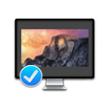configuration of your Mac -- especially if you do so frequently -- can become quite tedious.
Even if you only sometimes switch the resolution of a single display, you still have to open System Preferences, Find the Displays Preference and then often root through the available resolutions until you find the one you want.
Well, root no longer -- Now you can switch between your favorite display configurations with just a single click!
First, create a new Display Configuration item in any
Custom Items Tab Row. It begins life undefined:
Then, when you've got the display configuration of your Mac as you like it, simply click the new Display Configuration Item and it will "capture" your current display configuration.
Now, whenever you want to return your Mac to that configuration, just click the Display Configuration Item again and it will seamlessly restore your Mac to the captured display configuration -- including the sizes, resolutions and placements of all your displays.
The most common use for SuperTab's new Display Configuration Items is to create two or more of them, each capturing a common display configuration that you use. Then, when you want to switch to a particular display configuration, simply click the corresponding item in SuperTab and -- voilá! -- SuperTab sets it for you with no hassle!
Perhaps, you switch between resolutions of a single display. Perhaps you have one display configuration when at home and another for work or school.
Whatever your situation, you can now switch instantly between any configuration you commonly use with just a single click!
When you capture a display configuration into a Display Configuration item, the item's icon will change to reflect the actual relative sizes, locations and even desktop images of all your Mac's displays.
Further, SuperTab will indicate the current configuration in use by adding a checkmark to the corresponding Display Configuration item.
You can also give each item its own name, to help identify them.





